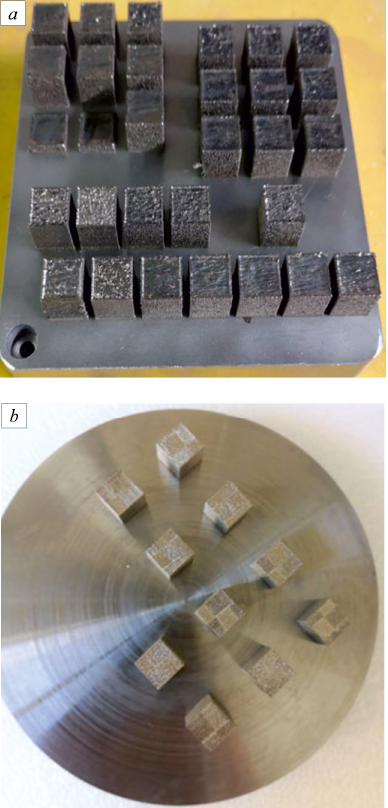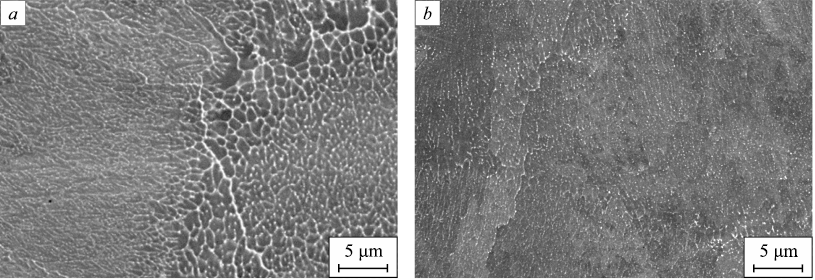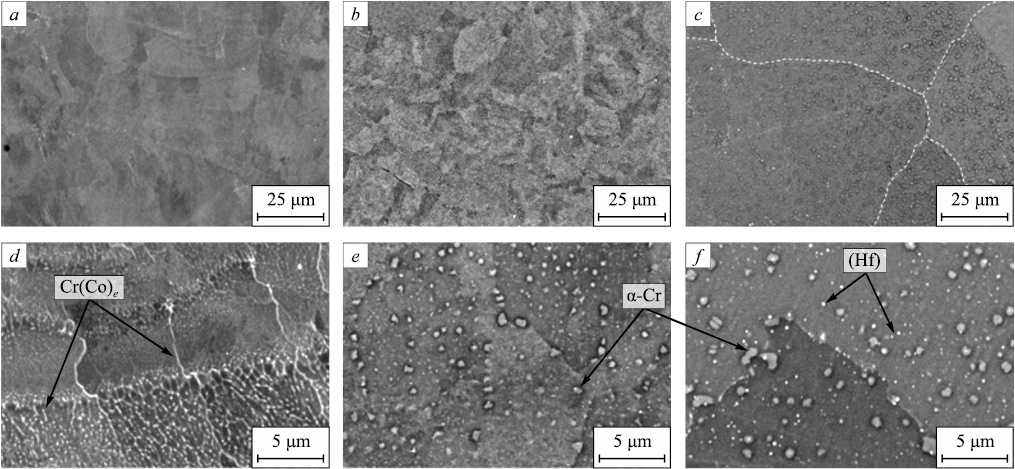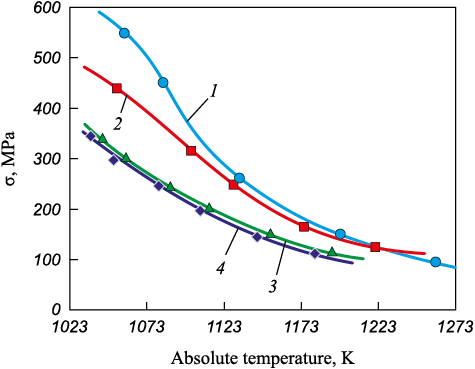Scroll to:
Influence of laser spot size on structure and properties of high-temperature CompoNIAL-M5-3 alloy produced by selective laser melting
https://doi.org/10.17073/0368-0797-2023-2-184-190
Abstract
The CompoNiAl-M5-3 high-temperature alloy based on nickel monoaluminide was obtained by selective laser melting (SLM) of a spheroidized powder with particle size in the range of 20 – 45 μm. The powder was manufactured using an integral technology including self-propagating high-temperature synthesis (SHS), briquette grinding, sieve and air classification followed with spheroidization of powder particles in a thermal plasma flow and ultrasonic purification of spheroidized particles from nanofraction. Using parametric studies, the SLM modes were tested on SLM 280H and TruPrint 1000 machines. Mechanical tests of the samples were carried out using the uniaxial compression scheme with the strain rate dε/dt = 10–4 s–1 in the temperature range 1023 – 1273 K. Scanning and transmission electron microscopy methods were used to study the influence of laser spot size on the evolution of microstructure and thermomechanical properties of the SLM-consolidated material in comparison with that obtained by hot isostatic pressing (HIP). The authors established the effect of HIP + HT (aging in vacuum) post-treatment on the structure and mechanical properties of the material. The yield strength at 1073 K of the alloy built on the additive machine with a laser spot diameter of 38 μm after SLM + HIP + HT was 500 MPa, which exceeded the yield strength of the HIP-samples by 220 MPa.
Keywords
For citations:
Kaplanskii Yu.Yu., Ageev M.I., Bychkova M.Ya., Fadeev A.A., Levashov E.A. Influence of laser spot size on structure and properties of high-temperature CompoNIAL-M5-3 alloy produced by selective laser melting. Izvestiya. Ferrous Metallurgy. 2023;66(2):184-190. https://doi.org/10.17073/0368-0797-2023-2-184-190
Introduction
Nickel monoaluminide (NiAl)-based heterophase alloys are utilized as structural material for the production of advanced turbine blades [1 – 3]. These alloys possess several desirable characteristics, including a high congruent melting point of the NiAl matrix (1911 – 1973 K), excellent thermal conductivity (λ ≈ 90 W/(m∙K)), relatively low density (<5.5 – 6.8 g/cm3), and superior resistance to oxidation at high-temperatures (>1073 K) compared to nickel superalloys [4 – 6]. However, these alloys exhibit low ductility under normal conditions and are susceptible to microcracking and crack propagation during blade machining and impacts [7 – 9]. These limitations restrict their application for the production ofintricate machined components. An alternative and more promising approach involves additive manufacturing of thin-wall parts (e.g., turbine blade airfoils) without machining processes [10; 11].
Selective laser melting (SLM) offers high precision and excellent surface quality. The quality of thin-walled components relies on the fusion conditions of the walls and the characteristics of equipment, particularly the laser spot size. The laser spot size affects both the surface finish and the metal structure by altering the melt volume during the fusion of the powder layer.
Numerous studies [12 – 16] investigated the compositions and fusion conditions required for manufacturing heat-resistant alloy powders based on NiAl for additive manufacturing purposes. Among these, the structured dispersion-hardened alloy known as CompoNiAl-M5-3 demonstrates the highest mechanical properties at test temperatures up to 1073 K. Additionally, it has been demonstrated that the mechanical properties are influenced by the manufacturing and post-processing technologies, which directly impact the microstructure of the alloy [13; 14]. The cast alloy with a average dendritic cell size of 100 μm and a cluster size of 5 mm exhibits a tensile strength (σв ) of up to 1720 MPa and plastic deformation (δ) of up to 8 %. Similarly, an alloy produced through hot isostatic pressing (HIP) of spherical powder in a mold exhibits σв = 2870 MPa (a 40 % increase) and δ = 16.8 %. Furthermore, the alloy demonstrates highly resistant to ductile plastic deformation, with a yield strength (σ0.2 ) of up to 392 MPa at 1073 K and a strain rate of 0.01 s\(^{-}\)1 [14].
According to [14], the significant strength increase in strength can be attributed to the reduction in NiAl grainsize, the presence of coherent solid solution α-Cr precipitations, and dispersed Hf-based particles. Additionally, the formation of thermostable Heisler phase Ni2AlHf nanoparticles along the grain boundaries contributes to this enhancement. Mechanical properties are further improved by utilizing a fine powder (20 – 45 μm). The powder is produced as follows:
– blending elemental powders;
– self-propagating high-temperature synthesis (SHS);
– grinding the sintered mass into powder;
– air sieve classification;
– plasma spheroidization;
– ultrasonic cleaning of the particles.
The spheroidized powder of the CompoNiAl-M5-3 alloy was successfully employed in the SLM fabrication of power turbine blades [17]. In our study, a similar powder was utilized to investigate the effects of laser spot size on the structure and mechanical properties of the CompoNiAl-M5-3 material.
Materials and Methods
The spherical powder of the CompoNiAl-M5-3 multicomponent alloy, with a particle size ranging from 20 – 45 μm, was produces through plasma spheroidization of the SHS-powder. The plasma spheroidization was performed using an arc plasma generator obtained from the Baikov Institute of Metallurgy and Materials Science, Russian Academy of Sciences. The flowability and bulk density of the powder (98 % spheroidization) are 19 s and 3.95 g/cm3, respectively.
For SLM, we employed an industrial-grade SLM 280HL machine (SLM Solution, Germany), equipped with a 400 W fiber laser, and an 80 μm spot size. Additionally, a TruPrint 1000 3D printer (TRUMPF GmbH + Co. KG, Germany) equipped with a 200 W fiber laser and a 38 µm spot size was used. The SLM process parameters were optimized through the fabrication of simple-shape test samples, with variations in the following process variables: laser power P = 175 ÷ 330 W; laser scanning speed v = 200 ÷ 500 mm/s, scanning pitch h = 0.1 ÷ 0.12 mm for SLM 280HL; and P = 50 ÷ 90 W, v = 400 ÷ 1000 mm/s and h = 0.05 ÷ 0.10 mm for TruPrint 1000.
We assessed the impact of the SLM process conditions on the residual porosity and microcracking. By identifying the optimal SLM condition, we achieved a laser energy density of 120 J/mm3 for SLM 280HL and 97.4 J/mm3 for TruPrint 1000, ensuring that the residual porosity remained below 0.5 %. Subsequently, we fabricated the samples for mechanical testing under these conditions, as depicted Fig. 1.
Fig. 1. Samples synthesized on SLM 280HL (a) and TruPrint 1000 (b) machines |
Heat treatment procedures were previously tested [17]. The samples, together with the build plate, were annealed in a Termionic T1-2000-160 vacuum resistance furnace (Termionic, Russia) at a residual pressure of 1.3·10\(^{-}\)5 Pa, with a temperature of 1423 K maintained for 3 h to relieve shrinkage stress. The heat treatment facilitated recrystallization of dendritic cells, grain formation, and dispersion hardening of the matrix by reieasing the excess α-Cr phase [17].
To address micro defects and enhance the mechanical properties of the samples, we employed HIP followed by aging. The samples underwent HIP at 1523 K and 145 MPa, followed by aging in a vacuum at 1073 K for 1.5 h.
The alloy structure was examined using an S-3400N scanning electron microscope (Hitachi, Japan) equipped with a NORAN System 7 X-ray Microanalysis System (Thermo Scientific, USA), and a JEM-2100 high-resolution transmission electron microscope (HP TEM) (Jeol, Japan) equipped with a JEOL Dual Tilt Beryllium Holder. Ultrathin foils for the HP TEM analysis were prepared using a PIPS II ion polishing system (Gatan, Inc., USA).
A uniaxial compression test was conducted using a Gleeble System 3800 thermal and mechanical testing system (Dynamic Systems Inc., USA) to evaluate the material’s response to a strain rate of dε/dt = 10\(^{-}\)4 s\(^{-}\)1 in the temperature range of 1023 – 1273 K. The chamber’s residual pressure was approximately 10\(^{-}\)3 Pa.
Results and Discussion
The microstructure of the samples, shown in Fig. 2 (XZ cross-section), revealed the presence of a dendritic grain structure with continuous interlayers of degenerate Cr(Co)e eutectics (50 – 400 nm thick) in the interdendritic space. Regardless of the fusion conditions of the powder layers, reducing the laser spot size (and laser scanning pitch) from 80 to 38 μm resulted in a halving of the NiAl grains and dendritic cells, accompanied by a decrease in melt volume and solidification time. The cell size decreased from 0.5 – 3.0 µm to 0.2 – 1.0 µm. Hafnium-containing nanoparticles, smaller than 100 nm, were irregularly distributed within the Cr(Co)e phase or at the NiAl/Cr(Co)e interface, contributing to dispersion strengthening. The structure and phase composition of the SLM alloy were discussed in [18].
Fig. 2. Microstructure of SLM-samples synthesized on the machines: |
The formation of the dendritic structure can be attributed to the non-equilibrium solidification of the melt during the SLM, occurring at a cooling rate of ~106 K/s, as well as the presence of excessive chromium content [14; 18].
Fig. 3 illustrates the evolution of the CompoNiAl-M5-3 alloy structure following annealing and gasostatic processing (HT). The annealing process facilitated the recrystallization of NiAl dendritic cells and the formation of uneven grains measured up to 50 μm in size (Fig. 3, b, e). The alloy structure of the CompoNiAl-M5-3 alloy exhibits α-Cr precipitations, measuring less than 1.5 μm in size, distributed uniformly along the grain boundaries and inside the NiAl grains. These α-Cr precipitations arise from concentration stratification effects within the supersaturated NiAl(Cr) solid solution, occurring both within the grains and at the interfaces of the grain interlayers. Extensive research covered in papers [13; 14; 17; 18] has extensively investigated the mechanisms of α-Cr precipitation growth, including spinodal decay and heterogeneous nucleation, using in situ TEM. During the powder bed fusion process, hafnium-containing nanoparticles (indicated by white contrast) precipitate as thin interlayers within the degenerate Cr(Co)e eutectics. Following annealing, these particles retain their original arrangement and become embedded within the α-Cr precipitation as a result of the Cr(Co)e segregation.
Fig. 3. Structure evolution of CompoNiAl-М5-3 SLM-alloy: |
Through gasostatic processing at 1523 K, the annealed CompoNiAl-M5-3 alloy samples undergo a homogenization process, resulting in a homogeneous, coarse-grained structure composed of the NiAl matrix, α-Cr precipitations, and nanoparticles of the hafnium-containing phases (Fig. 3, c, f ). The grain size ranges from 100 to 450 μm. The significant grain growth observed is attributed to diffusion and threshold creep behavior under simultaneous exposure to high temperature and pressure. At 1523 K, the alloy undergoes a transformation into a single-phase state (supersaturated solid solution). The α-phase is dissolved, and the alloy is homogenized. Upon subsequent cooling within the chamber, α-phase nucleation and growth take place. The excess α-Cr phase precipitations, mainly foung within the grains, exhibit a spherical morphology and reach sizes of up to 1.5 μm. On the contrary, elongated α-Cr particles, measuring up to 3 μm in size, form along the grain boundaries.
Fig. 4 illustrates the yield strength versus temperature curves at a strain rate of 10\(^{-}\)4 s\(^{-}\)1 for the CompoNiAl-M5-3 alloy samples. The curves compare the samples produced through SLM + HIP + HT using the SLM280HL and TruPrint 1000 machines with samples created through HIP and SLM alone. The resistance to plastic deformation of the SLM samples (SLM280HL) after annealing is comparable to that of the HIP samples when identical spherical powders are used. The two-step post-involving HIP and HT further enhances the compressive stress resistance within the temperature range of 1023 – 1173 K. For example, at 1073 K, the yield strength of the samples after SLM + HIP + HT ranges from 390 to 500 MPa, noticeably higher than the range of 260 – 280 MPa for the SLM and HIP samples. As the temperature increases, the difference diminishes to 11 – 20 MPa. The CompoNiAl-M5-3 alloy samples prodused using the TruPrint 1000 3D printer, with a laser spot size of 38 µm, exhibit the highest resistance throughout the entire temperature range. When comparing samples made through different additive technologies with the same phase compositions, the increase in alloy properties with a decrease in laser spot size and, consequently, the melt volume can be attributed to the refinement and more uniform redistribution of the refractory hafnium-containing phases.
Fig. 4. “Yield strength – temperature” graphs of CompoNiAl-М5-3 samples, |
The σ0.2 value at test temperatures up to 1173 K influenced by the alloy structure, particularly the average grain size. The NiAl samples after SLM + HIP + HT exhibit an average grain size of approximately 350 μm, while the HIP and SLM + annealing samples have an average grain size of less than 15 μm. The significant increase in grain size potentially retards Coble creep, as its contribution to the plastic flow becomes more prominent with decreasing temperature and grain size [19 – 22]. Above 1173 K, the alloy’s softening rate decreases since the highly coherent α-Cr precipitations within the grain volume, which significantly contribute to alloy hardening within the 1073 K temperature range, dissolve into the matrix.
Conclusions
The investigation of the microstructure and thermomechanical properties of the CompoNiAl-M5-3 alloy demonstrates that reducing the laser spot size enhances the resistance to ductile plastic deformation at temperatures up to 1173 K. This enhancement is attributed to the grinding process and a more uniform distribution of thermostable hafnium-containing phases within the NiAl matrix.
Gasostatic processing followed by aging in a vacuum further increases the resistance to ductile plastic deformation due to grain coarsening and the hardening effect of coherent precipitations of the excess α-Cr phase.
References
1. Pelleg J. Basic Compounds for Superalloys: Mechanical Properties. Amsterdam: Elsevier Inc.; 2018:494. https://doi.org/10.1016/c2017-0-04724-9
2. Bochenek K., Basista M. Advances in processing of NiAl intermetallic alloys and composites for high temperature aerospace applications. Progress in Aerospace Sciences. 2015;79:136–146. https://doi.org/10.1016/j.paerosci.2015.09.003
3. Shang Z., Shen J., Wang L., Du Y., Xiong Y., Fu H. Investigations on the microstructure and room temperature fracture toughness of directionally solidified NiAl–Cr(Mo) eutectic alloy. Intermetallics. 2015;57:25–33. https://doi.org/10.1016/j.intermet.2014.09.012
4. Wu S., Wu X., Wang R., Liu Q., Gan L. Effects of Ni vacancy, Ni antisite, Cr and Pt on the third-order elastic constants and mechanical properties of NiAl. Intermetallics. 2014;55: 108–117. https://doi.org/10.1016/j.intermet.2014.04.022
5. Noebe R.D. Physical and mechanical properties of the B2 compound NiAl. International Materials Reviews. 2012; 38(4):193–232. https://doi.org/10.1179/imr.1993.38.4.193
6. Wang L., Shen J., Shang Z., Fu H. Microstructure evolution and enhancement of fracture toughness of NiAl–Cr(Mo)–(Hf,Dy) alloy with a small addition of Fe during heat treatment. Scripta Materialia. 2014;89:1–4. https://doi.org/10.1016/j.scriptamat.2014.07.002
7. Dey G.K. Physical metallurgy of nickel aluminides. Sadhana. 2003;28:247–262. https://doi.org/10.1007/BF02717135
8. Geist D., Gammer C., Rentenberger C., Karnthaler H.P. Sessile dislocations by reactions in NiAl severely deformed at room temperature. Journal of Alloys and Compounds. 2015; 621:371–377. https://doi.org/10.1016/j.jallcom.2014.09.226
9. Miracle D.B. Overview No. 104. The physical and mechanical properties of NiAl. Acta Metallurgica et Materialia. 1993;41(3):649–684. https://doi.org/10.1016/0956-7151(93)90001-9
10. Gibson I., Rosen D.W., Stucker B. Additive Manufacturing Technologies: Rapid Prototyping to Direct Digital Manufacturing. New York: Springer; 2010:459. https://doi.org/10.1007/978-1-4419-1120-9
11. Plessis A. Effects of process parameters on porosity in laser powder bed fusion revealed by X-ray tomography. Additive Manufacturing. 2019;30:100871. https://doi.org/10.1016/j.addma.2019.100871
12. Ning H., Wang D., Zhao J., Wang B., Liu G. Fabrication and joining of NiAl and TiAl intermetallics by additive sintering. Materials Science and Engineering: A. 2022;849:143493. https://doi.org/10.1016/j.msea.2022.143493
13. Zaitsev A.A., Sentyurina Zh.A., Levashov E.A., Pogozhev Yu.S., Sanin V.N., Loginov P.A., Petrzhik M.I. Structure and properties of NiAl–Cr(Co,Hf) alloys prepared by centrifugal SHS casting. Part 1: Room temperature investigations. Materials Science and Engineering: A. 2017;690:463–472. https://doi.org/10.1016/j.msea.2016.09.075
14. Kaplanskii Yu.Yu., Korotitskiy A.V., Levashov E.A., Sentyurina Zh.A., Loginov P.A., Samokhin A.V., Logachev I.A. Microstructure and thermomechanical behavior of Heusler phase Ni2AlHf-strengthened NiAl–Cr(Co) alloy produced by HIP of plasma-spheroidized powder. Materials Science and Engineering: A. 2018;729:398–410. https://doi.org/10.1016/j.msea.2018.05.087
15. Nazarov A., Safronov V.A., Khmyrov R.S., Shishkovsky I. Fabrication of gradient structures in the Ni–Al system via SLM Process. Procedia IUTAM. 2017;23:161–166. https://doi.org/10.1016/j.piutam.2017.06.017
16. Khomutov M., Potapkin P., Cheverikin V., Petrovskiy P., Travyanov A., Logachev I., Sova A., Smurov I. Effect of hot isostatic pressing on structure and properties of intermetallic NiAl–Cr–Mo alloy produced by selective laser melting. Intermetallics. 2020;120:106766. https://doi.org/10.1016/j.intermet.2020.106766
17. Kaplanskii Yu.Yu., Levashov E.A., Korotitskiy A.V., Loginov P.A., Sentyurina Zh.A., Mazalov A.B. Influence of aging and HIP treatment on the structure and properties of NiAl-based turbine blades manufactured by laser powder bed fusion. Additive Manufacturing. 2020;31:100999. https://doi.org/10.1016/j.addma.2019.100999
18. Kaplanskii Yu.Yu., Zaitsev A.A., Levashov E.A., Loginov P.A., Sentyurina Zh.A. NiAl based alloy produced by HIP and SLM of pre-alloyed spherical powders. Evolution of the structure and mechanical behavior at high temperatures. Materials Science and Engineering: A. 2018;717:48–59. https://doi.org/10.1016/J.MSEA.2018.01.057
19. Kassner M.E. Fundamentals of Creep in Metals and Alloys. 3rd Edition. Oxford: Butterworth-Heinemann; 2015:338.
20. Nanocrystalline Titan. Garbacz H., Semenova I.P., Zherebtsov S., Motyka M. eds. Amsterdam: Elsevier; 2019:259.
21. Mouritz A.P. Introduction to Aerospace Materials. Amsterdam: Elsevier; 2012:600.
22. Zhang J.S. High Temperature Deformation and Fracture of Materials. Cambridge: Elsevier; 2010:365.
About the Authors
Yu. Yu. KaplanskiiRussian Federation
Yurii Yu. Kaplanskii, Cand. Sci. (Eng.), Research Associate of the Laboratory “In situ Diagnostics of Structural Transformations” of the Scientific and Educational Center SHS MISiS-ISMAN
4 Leninskii Ave., Moscow 119049, Russian Federation
M. I. Ageev
Russian Federation
Maksim I. Ageev, Postgraduate of the Chair of Powder Metallurgy and Functional Coatings, Junior Researcher of the Laboratory “In situ Diagnostics of Structural Transformations” of the Scientific and Educational Center SHS MISiS-ISMAN
4 Leninskii Ave., Moscow 119049, Russian Federation
M. Ya. Bychkova
Russian Federation
Marina Ya. Bychkova, Cand. Sci. (Eng.), Senior Lecturer of the Chair of Powder Metallurgy and Functional Coatings, Research Associate of the Scientific and Educational Center SHS MISiS-ISMAN
4 Leninskii Ave., Moscow 119049, Russian Federation
A. A. Fadeev
Russian Federation
Andrei A. Fadeev, Cand. Sci. (Eng.), Research Associate, Baikov Institute of Metallurgy and Materials Science, Russian Academy of Sciences; Scientific Project Engineer of the Scientific and Educational Center SHS MISiS-ISMAN, National University of Science and Technology “MISIS”
4 Leninskii Ave., Moscow 119049, Russian Federation
49 Leninskii Ave., Moscow 119991, Russian Federation
E. A. Levashov
Russian Federation
Evgeny A. Levashov, Dr. Sci. (Eng.), Prof., Head of the Chair of Powder Metallurgy and Functional Coatings, Director of the Scientific and Educational Center SHS MISiS-ISMAN
4 Leninskii Ave., Moscow 119049, Russian Federation
Review
For citations:
Kaplanskii Yu.Yu., Ageev M.I., Bychkova M.Ya., Fadeev A.A., Levashov E.A. Influence of laser spot size on structure and properties of high-temperature CompoNIAL-M5-3 alloy produced by selective laser melting. Izvestiya. Ferrous Metallurgy. 2023;66(2):184-190. https://doi.org/10.17073/0368-0797-2023-2-184-190





































